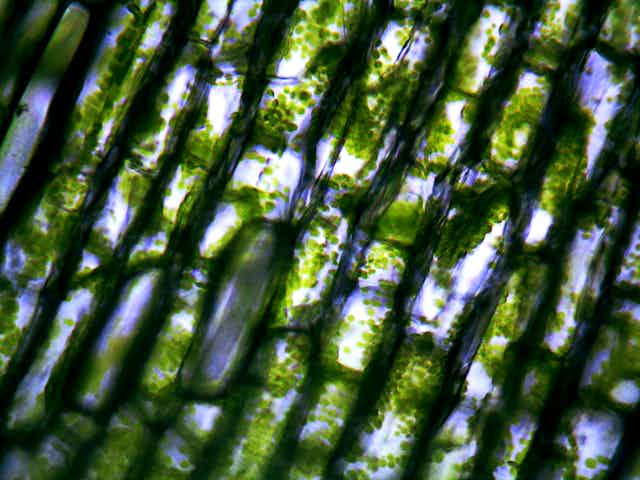For more than a billion years, plants have had an internal dialogue, and we are just beginning to learn the words. The unusual dialogue occurs between two compartments within plant cells – the nucleus and the chloroplast. It is a dialogue that continues today, and, according to research just published in Science, it shapes the productivity of plants.
All living organisms are made of cells. These cells contain many compartments, a bit like organs in an animal body. Each plant cell contains many chloroplasts, which are responsible for producing energy.
A billion years ago, the ancestors of chloroplasts existed as free-living individual cells, able to convert energy from light into sugar. But in a spectacular evolutionary event, these early chloroplasts were consumed by larger cells, where they eventually took up residence, supplying them with sugar. The legacy of that merger is evident around us every day in the green tissues of plants.
The fate of every plant cell is inextricably tied to the interaction between chloroplasts and other compartments of the plant cell. The most important of these interactions is with the nucleus.
The nucleus is the home of the genetic material for the plant – its genome. The genome contains all of the plant’s genes, written in DNA code. Like human beings, plants have tens of thousands of genes in the nucleus.
Each gene encodes a specific set of instructions – a recipe of sorts – for a particular cell component. The nucleus is like a non-circulating library for all of the plant’s genetic recipes. All the information is there, but it can’t leave the nucleus to be used elsewhere in the cell. In order to use the information in the recipe library, it has to be transcribed into a different kind of information molecule – an RNA transcript. The transcript is then transported out of the nucleus, where it is used as instructions to create a particular piece of cellular machinery.
Some of the genes in the nucleus are recipes for cellular machinery needed for the chloroplast to do its job – to undertake photosynthesis. It is important that the nucleus transcribes these genes in response to appropriate cues, especially daylight.
Light effects the transcription of one in every five plant genes. Intriguingly, some genes are transcribed based on a signal that comes from the chloroplast. The chloroplast informs the nucleus that certain genes need to be transcribed. Signalling from the chloroplast to the nucleus is called retrograde signalling. It has fascinated scientists for decades because the nature of the signal from the chloroplast is unknown.
Now this story has become even more intriguing. According to the Science paper, authored by Ezequiel Petrillo at the University of Buenos Aires and colleagues, it seems that this form of signalling from chloroplasts can do more than direct the transcription of genes – it can also direct modifications of the RNA transcribed from the genes. These transcripts are modified by splicing the RNA, which removes bits of superfluous information from them. Without splicing, most RNAs wouldn’t be able to encode proteins.
Petrillo and colleagues found a transcript that is spliced in different ways depending on whether light is present or not, and showed that the switch depended on the chloroplast’s signalling. The transcript in question encodes part of the cell’s splicing machinery, so the splicing process itself is regulated by a retrograde signal. That means that the effects can be broader than simply this one protein.
Whatever signal the chloroplast is producing, it must be able to move not just within the cell but also throughout the plant. If they shone light on the leaves, cells in the roots contained the spliced transcript. If they shone light on roots that do not contain active chloroplasts, the root cells did not contain the spliced transcript. This implies that the signal must travel from other tissues to the roots – so that the entire plant body is informed that the leaves have perceived light.
Finding out what this signal is would help researchers understand more about the process and perhaps exploit it for applications such as engineering plants that work in low light. One hypothesis was that the signal could be the sugars produced by chloroplasts, but that idea was shot down. Sugar-starved plants growing in the dark failed to produce any spliced transcript, as expected. But supplying them with sugars didn’t restore the splicing.
The signal has to be something new. Some have suggested candidate retrograde signals involved in other aspects of chloroplast communication with the nucleus, but we will have to wait for further studies to see if those are involved in the regulation of transcript splicing too.
Chloroplasts have resided in cells with a nucleus for about a billion years now. That the chloroplasts have discovered ways of communicating to the nucleus is not entirely surprising. That they communicate using a mechanism that remains a mystery is fascinating. Learning the “words” of their language, such as the retrograde signal for splicing, will provide illuminating discoveries for the coming years.

